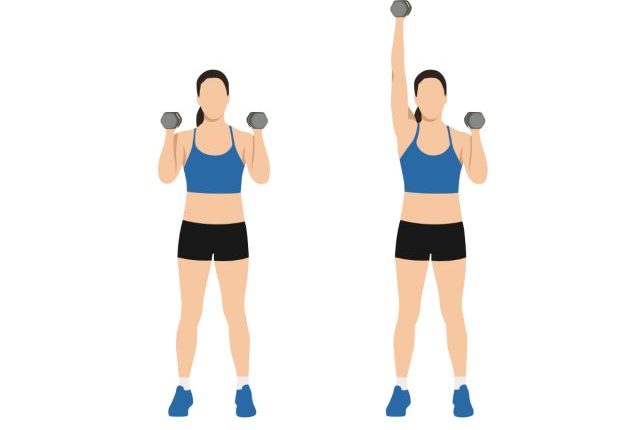These 10 Daily Free-Weight Exercises Enhance Balance & Mobility – Discovering a workout plan that not only shapes your body but also improves your balance and mobility is a treasure in the fitness realm. This is because gaining muscle often means losing out on flexibility and quickness, which are crucial for staying agile. However, by adding the following free-weight exercises to your daily routine, you can strengthen your muscles while also enhancing your balance and mobility. We got insights from Nadia Murdock, CPT, a certified fitness trainer at Garage Gym Reviews, who suggests 10 excellent free-weight exercises to boost your balance and mobility that you can easily incorporate into your daily exercise routine.
“Integrating weights into your workout offers numerous benefits, particularly when it comes to bettering your balance and mobility,” Murdock explains. “A key aspect to focus on for maintaining balance and mobility is strengthening your core, knees, hips, and ankles. It’s important for all your muscles to work together seamlessly, so keeping them balanced and strong is crucial.”
Studies have highlighted the importance of balance and mobility for healthy aging. As we get older, the likelihood of falls increases, underscoring the significance of participating in activities that enhance balance and mobility to diminish the risk of falls and related injuries. Moreover, these exercises are beneficial for joint health and improving functional strength.
Read on to learn more about the 10 best daily free weight exercises to improve your balance and mobility. After you’re finished, be sure to check out the 10 Best Exercises To Improve Your Muscular Endurance as You Age.
Single-Arm Overhead Press
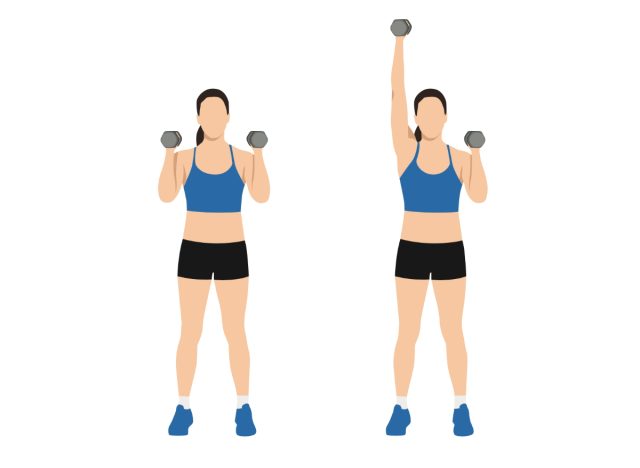

This free weight exercise will target your deltoids (shoulders) and engage your core for balance. Incorporating this movement into your routine will boost upper-body mobility and overall functional fitness.
“This move can be performed with your back against a stability ball pressed against a wall to increase the difficulty,” says Murdock. “With a dumbbell in one hand, push upward, bringing your shoulder blades down and together.” Do this for three sets of eight to 12 reps.
Rear Lateral Raise
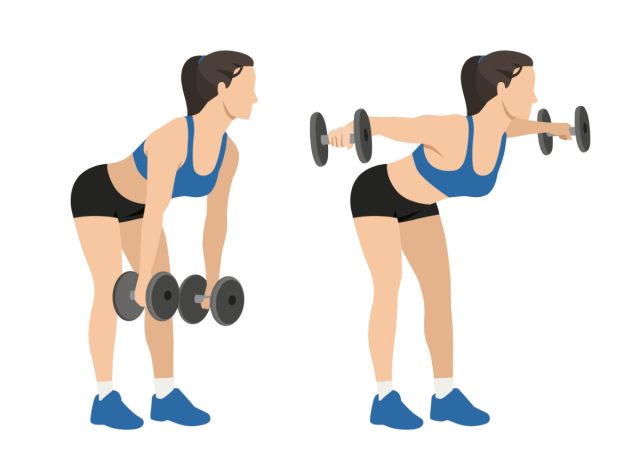

This movement helps improve posture and shoulder stability.
Murdock instructs, “While standing hip-width apart, bend at the waist until you’re parallel with the floor. Grab a challenging weight with a slight bend in the knees. Keeping your spine aligned and core engaged, slowly raise both weights to shoulder height.” Aim for three sets of 10 to 12 reps.
Standing Pull-up with Kettlebell
The standing pull-up engages the back muscles while integrating kettlebells for added resistance and increased strength gains.
“Standing with your feet hip-width apart, hold the kettlebell with both hands. Slowly raise the kettlebell toward your chest, keeping your elbows pointed outward. Lower the weight back to the starting point,” says Murdock. Repeat for three sets of 15 reps.
Chest Pass
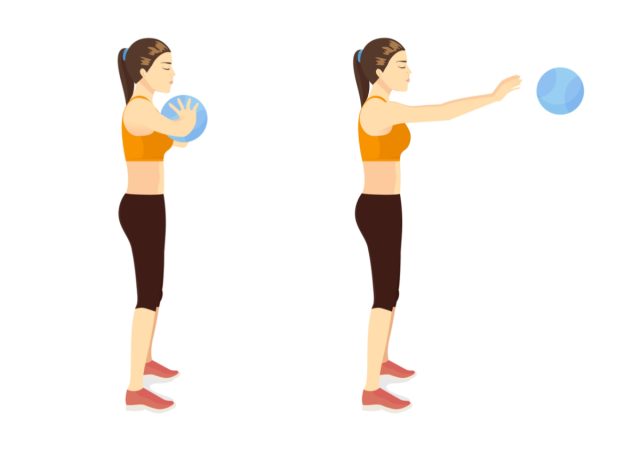

Using a medicine ball, the chest pass involves explosive movements, engaging your chest, shoulders, and core. Adding these into your routine will increase functional strength and boost your balance.
“Grab a medicine ball and get to work,” states Murdock. “Throw a six to eight-pound medicine ball against a wall while standing. Use force and catch it each time at chest level.” Complete four rounds of 25 reps.
Dumbbell Halos
This exercise involves circling a dumbbell around your head, engaging the shoulder muscles in a controlled manner. Including dumbbell halos in your routine can improve shoulder flexibility, an essential component for maintaining upper body mobility and balance.
“Not only is this move good for your core, but it’s also ideal for upper back and shoulders,” Murdock explains. “You’ll want to begin with your feet hip-width apart. Hold a dumbbell at a desirable weight. Make sure to hold the dumbbell end to end at the right hip. Keep a soft bend in your knees. Slowly bring the dumbbell up to your opposite shoulder and then halo it around the back of your head. The dumbbell should end down at your left hip. Repeat by alternating for a set amount of repetitions, make sure you do the same amount of reps on each side.” Aim for four rounds of 25 rotations.
Side Lunge with Dumbbells
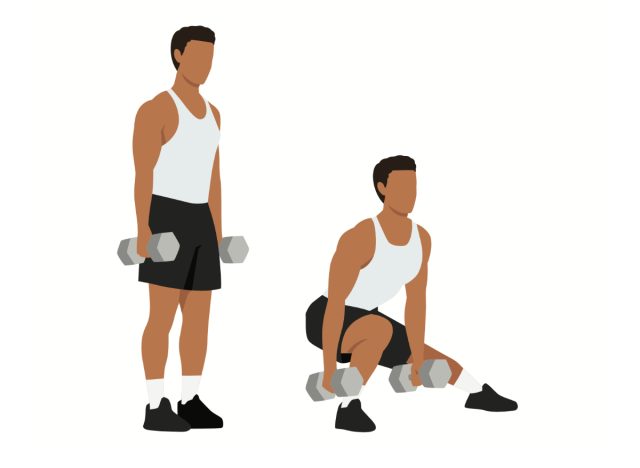

This exercise engages the muscles in the thighs and buttocks while promoting balance and stability.
Murdock tells us, “Standing with your feet together, step your right leg to the right and bend your right knee. Having dumbbells in each hand will want to frame the leg and get as close as possible to the ground, keeping a proud chest. Then, return to the center and repeat on the other side. This works your inner thighs. Adding the weight provides an additional challenge.” Complete three sets of 12 to 15 reps per leg.
Standing Oblique Crunches
This exercise targets the oblique muscles in your midsection while challenging your balance, making it a fantastic movement for boosting stability and mobility.
“Standing helps you to enable your core and legs at the same time, activating the entire body,” says Murdock. Start with your feet shoulder-width apart. Have one hand at the back of your head and the opposite arm extended by your side, holding a weight plate. Bend at the waist as you crunch or “dip” down to the side the weight plate’s on, then back up. Perform three sets of 15 reps per side.
Glute Bridge
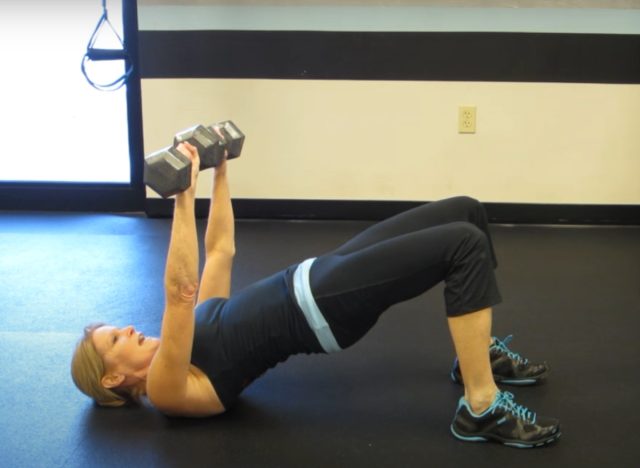

This simple yet effective move is a classic glute and hamstring builder—two muscles that promote lower body strength and stability.
“For this move, you will need a yoga mat and loop,” says Murdock. “Loop a short band around your knees and lie on your back. Bend your knees and keep them about eight inches apart with your feet rooted into the mat. Squeeze your glute muscles and elevate your hips no higher than hip height off the ground. At the same time, hold a set of dumbells just over your chest with your hands shoulder-width apart. Press the weights straight and hold as you perform the glute bridge. Hold this position for three to five seconds, then return your hips and arms to the beginning.” Do three sets of eight to 10 reps.
Clamshell
This unique movement improves hip mobility and strengthens the muscles around the hips for a serious boost to your balance.
Murdock instructs, “Lie on your side using your elbow as support with your knees bent. Place a weight just on top of your thighs. [Keeping] your knees stacked, open and close your top leg over the bottom while maintaining the weight on top of your thigh.” Perform three sets of 10 to 15 reps per side.
Squatted Side Steps
Squatted side steps engage the muscles in your thighs and buttocks, helping to promote better balance and mobility.
“Sit back into a squat position while keeping a heavy weight just in front of your chest,” says Murdock. “Hold the weight with both hands. From the low position, make sure your knees don’t surpass your toes. Keep your feet at least eight inches apart during the entire walk.” Take 10 steps to the right, then 10 steps to the left. Repeat for four rounds.
### FAQs
Frequently Asked Questions about Daily Free Weight Exercises for Balance & Mobility
What are free weight exercises?
Free weight exercises are physical workouts that involve the use of equipment not attached to any machinery or structure. This equipment includes dumbbells, barbells, kettlebells, and medicine balls. These exercises allow for a wider range of motion and engage more muscle groups, making them effective for improving balance and mobility.
How often should I perform these exercises to see improvements?
- Beginners: Start with 2-3 times a week to allow your body to adjust and recover.
- Intermediate to Advanced: Gradually increase to 4-6 times a week, depending on your fitness level and recovery ability.
Remember, consistency and progression are key to seeing improvements in balance and mobility. Make sure to listen to your body and rest as needed.
Can these exercises help with my balance issues?
Yes, daily free weight exercises can significantly help improve your balance. They challenge your body’s stability and proprioception, which are crucial for maintaining and improving balance. Start with simple exercises and gradually increase the difficulty as your balance improves.
Are there any safety tips I should follow while performing these exercises?
- Always ensure you’re using the correct form to prevent injuries.
- Start with lighter weights and gradually increase as your strength improves.
- Use a mirror to check your posture and alignment during exercises.
- If you’re new to free weights, consider working with a certified personal trainer to get started safely.
- Stop exercising immediately if you feel sharp pain or discomfort.
Do I need any special equipment to get started?
One of the advantages of free weight exercises is the minimal equipment needed. To start, all you need are some basic weights like dumbbells or kettlebells. As you progress, you might consider investing in additional weights or a bench, but it’s not necessary to get started.
Can I still do these exercises if I have limited space?
Absolutely! Free weight exercises are versatile and can be modified to fit into small spaces. Many exercises, such as squats, lunges, and dumbbell rows, require very little room. Just make sure you have enough space to move safely and avoid injury.
What should I do if I stop seeing improvements?
If you hit a plateau, it might be time to change your routine. Here are a few tips:
- Increase the weight or resistance level.
- Try different exercises to target muscles from various angles.
- Focus on the tempo of your exercises, incorporating slow, controlled movements.
- Incorporate other forms of training, such as HIIT or yoga, to keep your body challenged.
Remember, plateaus are a normal part of any fitness journey. The key is to stay consistent and be willing to adapt your routine as needed.

